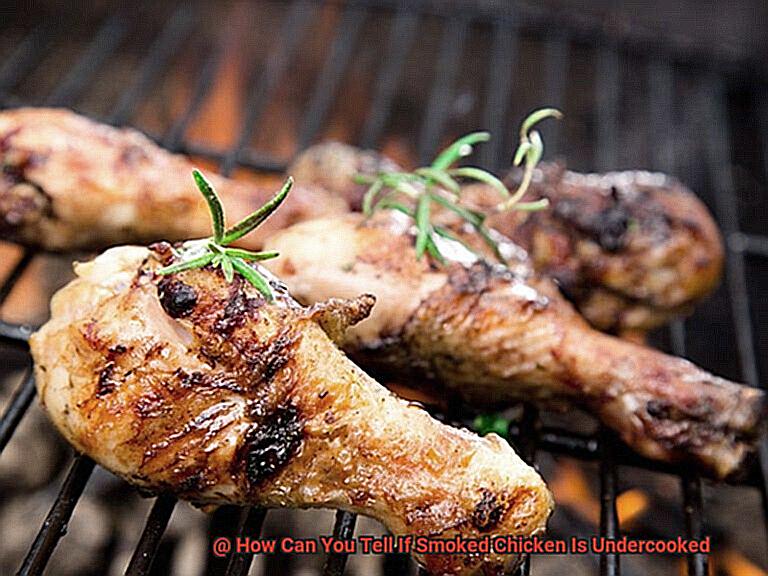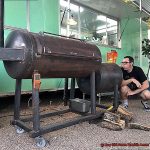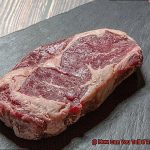Today, we’re diving into a burning question for all you barbecue enthusiasts out there: How can you tell if your smoked chicken is undercooked? Whether you’re a seasoned pitmaster or just a backyard grilling guru, nailing that perfect level of doneness is crucial for both taste and safety.
Smoking chicken adds an irresistible depth of flavor, but it also presents its own set of challenges. Unlike other cooking methods, smoking demands patience and precision to achieve that mouthwatering tenderness. After all, nobody wants to sink their teeth into what seems like a fully cooked piece of chicken, only to discover it’s not quite done yet.
In this comprehensive guide, we’ll walk you through the telltale signs and essential techniques that will help you determine if your smoked chicken is undercooked. From visual cues to internal temperature testing, we’ve got you covered with the knowledge you need to confidently serve up perfectly cooked poultry at your next BBQ bash. So let’s dig in and banish any undercooked chicken mishaps from your grill forever.
Contents
What Is Smoked Chicken?
Prepare yourself for an unforgettable culinary experience with smoked chicken. Picture sinking your teeth into tender, juicy meat infused with the mouthwatering aroma of smoky goodness. Whether you’re a barbecue enthusiast or a curious food lover, smoked chicken is a journey that will leave you craving for more.
The Smoking Process:
To embark on this delicious adventure, start by marinating or seasoning the chicken with your favorite spices. This prepares the meat for the smoking process and enhances the flavors. Next, the chicken is placed on a grill or in a smoker, where it undergoes slow cooking over low heat for several hours. The smoke generated from wood chips or chunks adds a distinctive smoky flavor that permeates every inch of the meat.
Different Cuts, Different Flavors:
Smoked chicken offers a variety of cuts each with its own unique texture and flavor. Whole chickens provide an all-encompassing smoky experience as the larger surface area allows for more smoke penetration. Chicken breasts, wings, or drumsticks can also be smoked, offering delightful variations in taste and texture.
Advantages of Smoking:
Smoking chicken not only provides irresistible flavor but also offers several advantages over other cooking methods. The slow and steady heat breaks down connective tissues in the meat, resulting in tender and juicy chicken that practically melts in your mouth. Additionally, smoking helps render out excess fat from the meat, making it a leaner option compared to traditional frying or grilling.
Determining Doneness:
Ensuring your smoked chicken is fully cooked is crucial for both taste and safety. Use a reliable meat thermometer to check that the internal temperature reaches 165°F (74°C). In addition, look for white meat throughout, clear juices, and a firm yet juicy consistency.
Beyond the Plate:
Smoked chicken is incredibly versatile and can be enjoyed in various ways. Whether it’s the star of your backyard barbecue or incorporated into salads, sandwiches, or pasta dishes, the options are endless. Its rich smoky flavor adds depth and complexity to any recipe, making it a favorite choice for chefs and home cooks alike.
The Importance of Internal Temperature
Get ready to embark on a mouthwatering journey as we dive into the science behind achieving perfectly cooked, safe-to-eat smoked chicken. So grab your apron, fire up those grills, and let’s uncover the secrets to culinary excellence.
Safety First: The Battle Against Bacteria
When it comes to poultry, safety should always be our top priority. Cooking chicken to the proper internal temperature is crucial, as it unleashes a fiery assault on harmful bacteria like Salmonella and Campylobacter that can wreak havoc on our digestive systems. To ensure safety, make sure the internal temperature reaches a minimum of 165°F (74°C).
Visual Cues Can Be Deceptive: Enter the Meat Thermometer
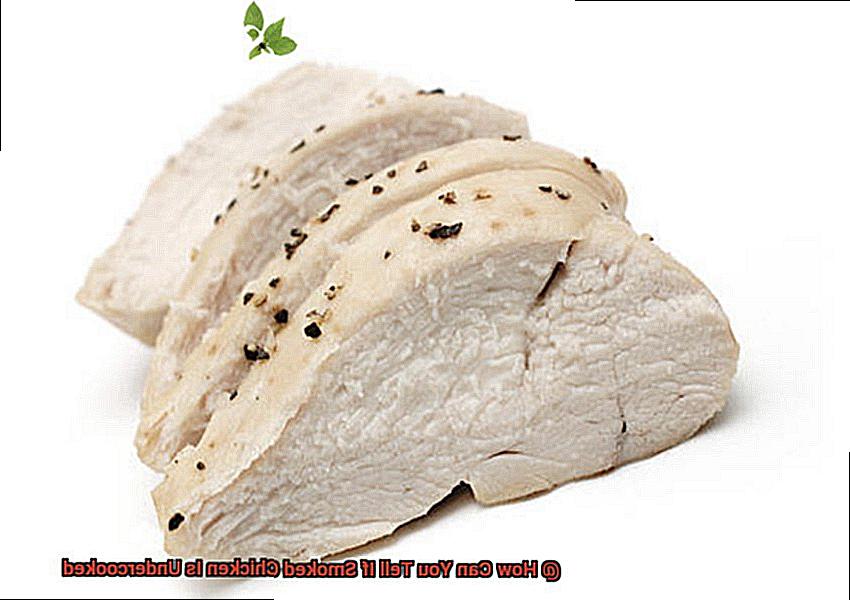
The golden-brown color of smoked chicken may tempt you to take a leap of faith and dig in, but relying solely on visual cues is a risky game. Looks can be deceiving, leaving you with undercooked chicken and potential stomach troubles. Instead, arm yourself with a trusty meat thermometer for the most accurate results.
Mastering the Art of Thermometer Placement
To unlock the true secrets hidden within your smoked chicken, you must know where to seek them. Insert the meat thermometer into the thickest part of the chicken without touching the bone. Bones have their own agenda, with different heat conductivity levels that can lead to false readings.
Different Parts, Different Temperatures: A Symphony of Flavors
Just like a symphony that combines different instruments to create a masterpiece, each part of the chicken requires its own temperature to shine. Dark meat, such as succulent drumsticks and heavenly thighs, should reach a slightly higher internal temperature than their white meat counterparts, like the tender breasts. By understanding these variations, you ensure that every piece is cooked to perfection.
Resting for Juicy Delight: Let the Flavors Dance
Once your smoked chicken reaches the desired internal temperature, resist the temptation to pounce on it immediately. Allow it to rest for a few minutes, and witness the magic as the juices within dance and mingle, resulting in a more succulent and flavorful experience.
Avoiding Catastrophe: The Art of Tender Perfection
Overcooking chicken can turn your culinary masterpiece into a dry and tough disappointment. By closely monitoring the internal temperature, you can save yourself from this catastrophe and achieve a symphony of tenderness, moistness, and deliciousness in every bite.
Observing the Color and Texture of the Meat
Imagine a sunny summer day, the aroma of smoked chicken filling the air as you master the art of grilling. But how do you ensure that your chicken is cooked to perfection? Fear not, my fellow grill masters, because today we are delving into the importance of observing the color and texture of smoked chicken.
The Color Code:
When it comes to smoked chicken, the color is a chef’s badge of honor. A golden brown or caramelized exterior signifies that your chicken has been cooked at the perfect temperature. But remember, the skin’s color can vary due to seasonings or marinades, so focus on the meat itself.
The Texture Test:
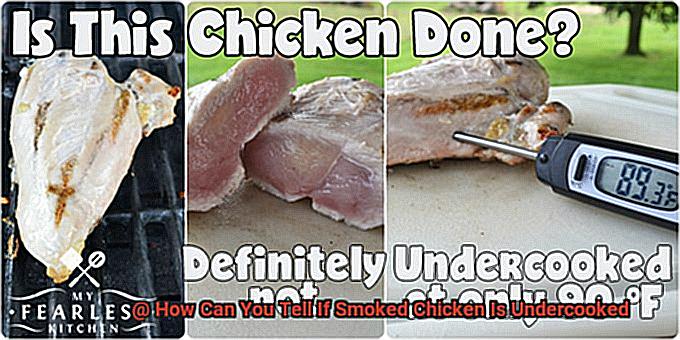
Texture is key in determining whether your smoked chicken is fit for consumption. Picture sinking your teeth into moist, juicy meat that melts in your mouth – that’s what we’re aiming for. Overcooked chicken becomes dry and stringy, while undercooked chicken is rubbery or chewy.
The Anatomy of Doneness:
To ensure perfectly smoked chicken, go to its core. Slicing into the meat should reveal an opaque and white interior. Any pinkness or translucency is a clear sign of undercooking. Remember, bone-in chicken pieces may need extra attention as bones can affect cooking times.
Measuring Success:
Our senses are powerful tools, but sometimes we need technology’s assistance. Enter the trusty meat thermometer. Insert it into the thickest part of the chicken without touching bone or fat. A reading of 165°F (74°C) guarantees fully cooked chicken, eliminating worries about lurking foodborne bacteria.
Visual Cues:
Don’t fret if you lack a meat thermometer; visual cues can save the day. A simple fork or knife becomes your trusty sidekick. Pierce the meat and observe the color of the juices that escape. Clear juices signify fully cooked chicken, while pink or reddish juices signal the need for more grill time.
Conclusion:
Observing the color and texture of smoked chicken is an art form that every grill master should master. Aim for a golden brown color, a uniform white interior, and a moist yet tender texture to achieve culinary excellence. Whether you rely on a meat thermometer or visual cues, the goal remains the same: a safe and mouthwatering smoked chicken experience.
Cutting Into the Chicken to Test Doneness
Unlock the secrets of determining the doneness of your smoked chicken and say goodbye to those disappointing bites of pink, raw meat. Not only is undercooked chicken unappetizing, but it also poses a risk of foodborne illnesses. But fear not. With a few techniques at your disposal, you can ensure that your smoked chicken is cooked to perfection every time.
The first method we recommend is using a meat thermometer, your personal grill master. The USDA advises cooking chicken to an internal temperature of 165°F (74°C) for safe consumption. Simply insert the thermometer into the thickest part of the chicken, avoiding bones, and wait for the reading to stabilize. If it falls short of 165°F (74°C), it’s back on the grill it goes until it reaches the recommended temperature.
But what if you lack a meat thermometer? Don’t worry, we’ve got you covered. The second method involves cutting into the chicken to check its doneness. However, remember this should be your last resort or used when a thermometer is unavailable. Make a small incision in the thickest part and observe. Undercooked chicken reveals a pinkish hue or raw appearance in the center, with a rubbery or overly soft texture. Properly cooked chicken boasts a white or slightly pink center with clear juices.
But wait, there’s more. Before you dig in, let your smoked chicken rest for a few minutes after reaching the desired temperature. This allows the juices to redistribute within the meat for a more flavorful and tender final product. It’s worth the wait, trust us.
Pay Attention to Tenderness
Imagine the scene: you’ve painstakingly tended to your smoker for hours, eagerly anticipating the moment when the intoxicating aroma of smoked chicken fills the air. Finally, the time has come to unveil your culinary masterpiece. With anticipation building, you take that first bite – only to be met with disappointment. The chicken is undercooked, its texture rubbery, and a hint of pink lingers in the center. All your effort seems wasted.
To avoid this culinary catastrophe, it is crucial to pay attention to the tenderness of your smoked chicken. Tenderness is not just about achieving a pleasant texture; it is also an essential indicator of doneness and safety. In this regard, let us delve into why paying attention to tenderness is vital when grilling smoked chicken.
First and foremost, the texture of the meat speaks volumes about its doneness. Undercooked chicken will feel tough and rubbery in your mouth, while properly cooked chicken should be tender and succulent. When you take a bite, the meat should effortlessly pull apart and melt in your mouth – a little slice of heaven.
Next, let us consider color. While color alone is not foolproof, it can provide insights into tenderness. Undercooked chicken may retain a pinkish hue in the center, while fully cooked chicken should be uniformly white throughout. If you spot any pink or raw-looking spots, it’s time to return that chicken to the smoker.
Now, how do you determine when your smoked chicken has reached its peak tenderness? The answer lies in internal temperature. The ideal internal temperature for fully cooked smoked chicken is 165°F (74°C), ensuring that any harmful bacteria within the meat have been eradicated. Use a meat thermometer to gauge the temperature at the thickest part of the meat; if it falls below 165°F (74°C), the chicken needs more time on the smoker.
Here’s the tricky part: overcooking. Yes, you read that right. Overcooking can result in dry and tough meat – the last thing you want after investing so much effort. The key lies in finding the delicate balance between tenderness and doneness. This is where paying attention to both visual cues and internal temperature readings becomes crucial.
Trusting Your Senses
Imagine yourself in your backyard, surrounded by the irresistible scent of smoky goodness. Your mouth waters in anticipation of sinking your teeth into a succulent piece of perfectly grilled smoked chicken. But before you indulge, it is essential to trust your senses and ensure that your chicken is cooked to perfection.
After all, undercooked poultry can ruin the entire experience, leaving you with a disappointing and potentially unsafe meal. So, let’s dive into why trusting your senses is crucial when grilling smoked chicken.
First and foremost, let’s talk about sight. When inspecting your smoked chicken, take a moment to closely examine its appearance. The outside should boast a beautiful golden brown color, signaling that it has been cooked to perfection.
Every inch of the chicken should be adorned in this lovely hue, promising a delectable and well-cooked meal. If you spot any pink or raw patches, it’s a clear indication that your chicken needs more time on the grill. Trust your eyes to guide you towards that glorious golden-brown finish.
Next, let’s move on to touch. This sense can provide valuable insights into the doneness of your smoked chicken. Gently press the chicken with your fingertips – it should feel firm and resilient, springing back when touched. The texture should be pleasingly firm, indicating that the meat has been cooked thoroughly. If it feels soft or squishy, it’s a telltale sign that it’s not yet fully cooked and needs more time on the grill. For an extra layer of certainty, invest in a good meat thermometer. Insert it into the thickest part of the chicken and make sure it reads at least 165°F (74°C). This temperature ensures that any harmful bacteria lurking within have been annihilated and guarantees moist and juicy meat.
Ah, the aroma. Our sense of smell is an often underestimated tool in determining the doneness of smoked chicken. Take a moment to inhale deeply the tantalizing aroma wafting from your grill. If it smells raw or has a strong odor, it may not have cooked through entirely. On the other hand, if you’re greeted with a delightful smoky aroma that screams “cooked to perfection,” then you’re on the right track. Trust your nose to guide you towards that mouthwatering flavor.
Now, remember that trusting a single sense might not always give you an accurate assessment of doneness. It’s vital to rely on a combination of sight, touch, and smell for the best results. By embracing the power of your senses, you’ll be able to confidently determine if your smoked chicken is ready to be devoured.
VnXVh3fXdzA” >
Conclusion
In conclusion, ensuring that your smoked chicken is cooked to perfection requires a combination of techniques and careful observation. Pay attention to visual cues, internal temperature, tenderness, and trust your senses to guarantee a mouthwatering meal.
Visual cues are key indicators of doneness. Look for a tantalizing golden brown color on the outside of the chicken, focusing on the meat itself rather than any seasonings or marinades that may alter the skin’s appearance.
For foolproof accuracy, rely on a trusty meat thermometer. The USDA advises an internal temperature of 165°F (74°C) for safe consumption. Insert the thermometer into the thickest part of the chicken without touching bone or fat to obtain an accurate reading.
Don’t forget about tenderness. Undercooked chicken will leave you with a tough and rubbery texture in your mouth. On the other hand, properly cooked chicken should be tender and succulent—so tender that it effortlessly pulls apart and melts in your mouth.
Let your senses guide you as well. Sight, touch, and smell all play important roles in assessing doneness. Seek out that irresistible golden brown color, feel for firmness when touched, and savor the delightful smoky aroma wafting from your grill.
By combining these techniques and trusting your instincts, you can confidently determine if your smoked chicken is ready to be savored.

